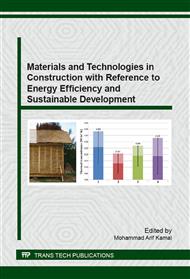[1]
G. Minke. Building with earth. Design and Technology of a Sustainable Architecture. Birkhauser (2006).
Google Scholar
[2]
N. Scarlat, M. Martinov, J. F. Dallemand. Assessment of the availability of agricultural crop residues in the European Union: Potential and limitations for bioenergy use. Waste Management 30 (2010) 1889–1897.
DOI: 10.1016/j.wasman.2010.04.016
Google Scholar
[3]
N. R Bronsema. Moisture movement and mould management in straw bale walls for a cold climate. Master Thesis, Department of Civil and Environmental Engineering, University of Waterloo, Waterloo (2010).
Google Scholar
[4]
J. Vejeliene, A. Gailius, S. Vejelis, S. Vaitkus, G. Balciunas. Development of thermal insulation from local agricultural waste. Environmental engineering (2011), 437- 440.
Google Scholar
[5]
J. Wihan. Humidity in straw bale walls and its effect on the decomposition of straw. PhD Thesis, University of East London School of Computing and Technology, London (2007).
Google Scholar
[6]
M. Lawrence, A. Heath, P. Walker. Determining moisture levels in straw bale construction. Construction and Building Materials (2009), 2763–2768.
DOI: 10.1016/j.conbuildmat.2009.03.011
Google Scholar
[7]
L. Zaho. Novel bio-composites based on whole utilization of wheat straw. PhD Thesis, Brunel University, London (2013).
Google Scholar
[8]
CP. Hedlin. Sorption isotherms of five types of grain straw at 70°F. Can Agri Eng 9 (1967), 37-42.
Google Scholar
[9]
L. Malmquist. Sorption as deformation of space. Kylteknisk Tydskrift 4 (1958), 49–57.
Google Scholar
[10]
L. Malmquist. Sorption of water vapour by wood from the standpoint of a new sorption theory. Holz als Roh und Werkstoff 5 (1959), 171–178.
DOI: 10.1007/bf02608808
Google Scholar
[11]
W. Xia, Y. G. Kang, J. H. Song, and K. Tarverdi. Biopolymer Composites Reinforced with Fractioned Wheat Straw. Paper presented at the Advances in Ecomaterials: International Conference on Eco-Materials (ICEM8), Brunel University, Department of Design (2007).
Google Scholar
[12]
W. Xia, J. Song, K. Tarverdi, and Y. G. Kang. Wheat Straw and Wheat Flour Biocomposites Prepared by Extrusion Process. Journal of Biobased Materials and Bioenergy, 4 (2010), 172-180.
DOI: 10.1166/jbmb.2010.1082
Google Scholar
[13]
Y. G. Kang, W. Xia, J. H. Song, and K. Tarverdi. Extrusion fractionation of wheat straw for biocomposites utilising the entire straw constituents. International Journal of Materials and Product Technology, 36(1-4), 334-347.
DOI: 10.1504/ijmpt.2009.027840
Google Scholar
[14]
B. Xiao, X. F. Sun, and R. C. Sun. Chemical, structural and thermal characteristics of alkali-soluble lignins and hemicelluloses, and cellulose from maize stems, rye straw and rice straw. Polymer Degradation and Stability 74 (2001), 307-319.
DOI: 10.1016/s0141-3910(01)00163-x
Google Scholar
[15]
H. M Künzel. Simultaneous heat and moisture transport in building components. Dissertation. University of Stuttgart, Stuttgart, (1995).
Google Scholar
[16]
T. Padfield. The role of absorbent building materials in moderating changes of relative humidity. PhD Thesis. The Technical University of Denmark, Department of Structural Engineering and Materials, (1999).
Google Scholar
[17]
M. Hall, D. Allinson. Analysis of the hygrothermal functional properties of stabilised rammed earth materials. Building and Environment 44 (2009) 1935–(1942).
DOI: 10.1016/j.buildenv.2009.01.007
Google Scholar
[18]
T. Ashour, H. Wieland, H. Georg, F.J. Bockisch, W. Wu. The influence of natural reinforcement fibres on insulation values of earth plaster for straw bale buildings. Materials & Design, 31 (2010), 4676-4685.
DOI: 10.1016/j.matdes.2010.05.026
Google Scholar
[19]
S. Liuzzi. Experimental Investigation on Earthen Building Materials. Hygrothermal and Physical performances. LAP Lambert Academic Publishing, (2012).
Google Scholar
[20]
Ente Nazionale Italiano di Unificazione. 2008, UNI EN 1015-19, Methods of test for mortar for masonry - Determination of water vapour permeability of hardened rendering and plastering mortars (in Italian).
DOI: 10.3403/01541425u
Google Scholar
[21]
S. Liuzzi, M.R. Hall, P. Stefanizzi, S.P. Casey. Hygrothermal behaviour and relative humidity buffering of unfired and hydrated lime-stabilised clay composites in a Mediterranean climate. Building and Environment 61 (2013) 82-92.
DOI: 10.1016/j.buildenv.2012.12.006
Google Scholar
[22]
Italian Government (2005). Legislative Decree 19th August 2005, n. 192, complying with the European Directive 2002/91/CE on the energy performance of buildings. (In Italian).
Google Scholar
[23]
Ente Nazionale Italiano di Unificazione. 2008, UNI EN ISO 13786, Thermal performance of building components - Dynamic thermal characteristics - Calculation methods (in Italian).
Google Scholar
[24]
Ente Nazionale Italiano di Unificazione. 2013, UNI EN ISO 13788, Hygrothermal performance of building components and building elements – Internal surface temperature to avoid critical surface humidity and interstitial condensation - Calculation methods (in Italian).
DOI: 10.3403/30230945
Google Scholar


